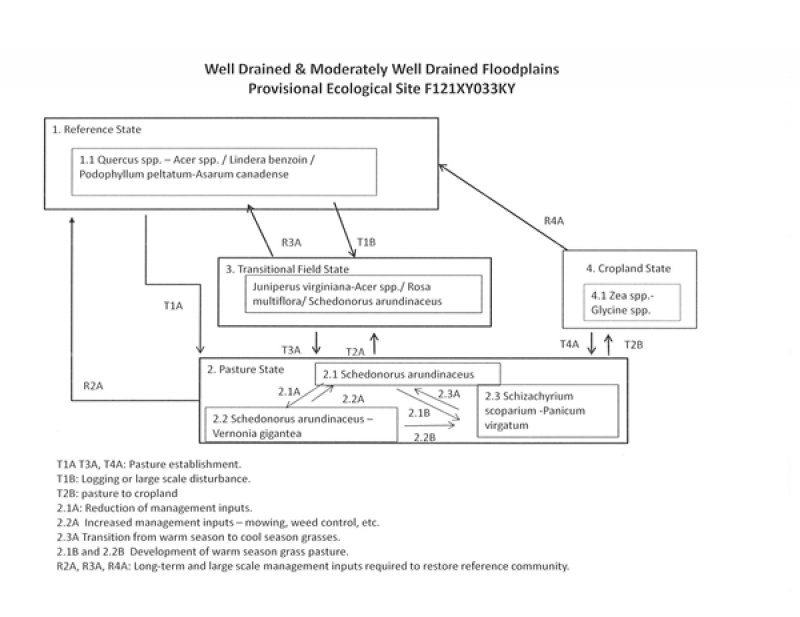
Natural Resources
Conservation Service
Ecological site F121XY033KY
Well Drained & Moderately Well Drained Floodplain
Last updated: 10/01/2024
Accessed: 12/21/2025
General information
Provisional. A provisional ecological site description has undergone quality control and quality assurance review. It contains a working state and transition model and enough information to identify the ecological site.
MLRA notes
Major Land Resource Area (MLRA): 121X–Kentucky Bluegrass
General: MLRA 121 is in Kentucky (83 percent), southern Ohio (11 percent), and southern Indiana (6 percent). It makes up about 10,680 square miles (27,670 square kilometers). The cities of Cincinnati, Ohio, and Louisville, Frankfort, and Lexington, Kentucky, are in this area.
Physiography: This area is primarily in the Lexington Plain Section of the Interior Low Plateaus Province of the Interior Plains.
Soils: The dominant soil orders in MLRA 121 are Alfisols, Inceptisols, and Mollisols. The soils in the area dominantly have a mesic soil temperature regime, an udic soil moisture regime, and mixed mineralogy. They are shallow to very deep, generally well-drained, and loamy or clayey. Hapludalfs formed in residuum on hills and ridges (Beasley, Cynthiana, Eden, Faywood, Lowell, and McAfee series) and in loess over residuum on hills and ridges (Carmel and Shelbyville series). Paleudalfs (Crider and Maury series) formed in loess or other silty sediments over residuum on hills and ridges. Fragiudalfs (Nicholson series) formed in loess over residuum on ridges. Hapludolls formed in residuum on hills and ridges (Fairmount series) and in alluvium on floodplains (Huntington series). Eutrudepts (Nolin series) formed in alluvium on flood plains.
Geology: Most of this area has an Ordovician-age limestone that has been brought to the surface in the Jessamine Dome, a high part of a much larger structure called the Cincinnati Arch. The strata of limestone have a propensity to form caves and karst topography. Younger units of thin-bedded shale, siltstone, and limestone occur at the eastern and western edges of the area.
The area has no coal-bearing units. Pleistocene-age loess deposits cover most of the bedrock units in this MLRA, and some glacial lake sediments are at the surface in the northwest corner of the area. Unconsolidated alluvium is deposited in the river valleys.
Classification relationships
Scientific Name: South-Central Interior Mesophytic Forest Unique Identifier: CES202.887
Deep Soil Mesophytic Forest (Kentucky State Nature Preserves Commission)
Ecological site concept
The Well Drained & Moderately Well Drained Floodplain ecological site occurs on flooded alluvial soils. Representative soils include: Boonesboro, Boonewood, Bruno, Chagrin, Combs, Dearborn, Egam, Elk, Grigsby, Haplic Udarents, Huntington, Jules, Lindside, Mollic Udarents, Nelse, Nolin, Sensabaugh, Skidmore, Stonelick, Udarents.
State 1. (Reference): Provisional Ecological Site (PES)F121XY033KY
State 1, Phase 1.1: Plant species dominants:
Quercus spp. – Acer spp. /Lindera benzoin/Podophyllum peltatum-Asarum canadense
(oak – maple / spicebush/ mayapple-wild ginger).
Narrative: These sites are found on well drained and moderately well drained floodplains with deep soils. Most of these sites in MLRA 121 are utilized as cropland or pasture; however the reference community would be a hardwood deciduous forest.
Reference sites would likely include a mix of Quercus spp. (oaks), Acer saccharum (sugar maple), Acer rubrum (red maple), Fraxinus spp. (ash), Juglans nigra (black walnut), Ulmus Americana (American elm) and Carya species (hickories). Tree species vary depending on site conditions, disturbances, and micro-topography. Other tree species may include: Without disturbances, a rich herb and forb layer would be present including an array of spring wildflowers.
State: 2. Pasture
State 2, Phase 2.1: Managed Pasture. Plant species dominant: Schedonorus arundinaceus (tall fescue)
State 2, Phase 2.2: Minimally Managed Pasture. Plant species dominants: Rosa multiflora- Rubus spp. /Schedonorus arundinaceus
State 2, Phase 2.3: Warm-season Pasture. Plant species dominants depend on landowner objectives and site characteristics, but may include: switchgrass (Panicum virgatum), little bluestem (Andropogon scoparius), indianagrass (Sorghastrum nutans), big bluestem (Andropogon gerardii), and eastern gamagrass (Tripsacum dactyloides).
State: 3 – Transitional Field
State 3, Phases 3.1: Plant species dominants:
Juniperus virginiana / Rosa multiflora/ Vernonia gigantea -Schedonorus arundinaceus.
(Eastern red cedar / multiflora rose/ ironweed-tall fescue)
State: 4. Cropland
State 4, Phase 4.1: Plant species dominants: dependent upon seeding and management. Most common crops are corn and soybeans.
Associated sites
| F121XY030KY |
Poorly Drained & Very Poorly Drained Floodplain Poorly drained and Very Poorly Drained Floodplains |
|---|---|
| F121XY031KY |
Somewhat Poorly Drained Floodplain Somewhat Poorly Drained Floodplains |
Table 1. Dominant plant species
| Tree |
(1) Quercus rubra |
|---|---|
| Shrub |
(1) Asimina triloba |
| Herbaceous |
(1) Podophyllum peltatum |
Click on box and path labels to scroll to the respective text.
